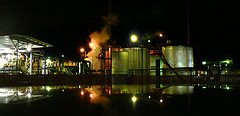 Industrial noise is an inevitable part of using heavy machinery, but it can become a
Industrial noise is an inevitable part of using heavy machinery, but it can become a
serious issue due to the potential for permanent hearing damage when workers experience prolonged exposure to high noise levels. As a result, noise reduction strategies are extremely important and should be constantly and actively in place in order to reduce the risk of injury to industrial workers.
Following are some guidelines for protecting employees from excessive noise caused by industrial machinery.
Identifying Excessive Noise Sources
A common place to find excessive noise levels is within the gear drive units. Some level of noise is natural, as the components of the gear drive move and thus vibrate. Higher noise levels are typically caused when one or more of these components move out of line with the rest, though many factors can cause increased noise and vibration.
For example, a single Falk reducer has numerous parts that must run perfectly in sync to minimize noise levels. If any one of these is out of whack, such as input or output shaft misalignment, the vibration noise can increase significantly.
If the noise from a gear drive has reached excessive levels, sound tests should be run in an effort to isolate the location of excessive noise within the gear drive. Depending on what’s causing the noise, there may be a number of gearbox repairs or alterations that could resolve the problem.
Gear Repairs and Alterations
Most of the noise potential within a gearbox comes from the interaction between gears, which produces vibration. While the machine’s performance requirements can restrict the available options for reducing gear noise, there are some strategies that may be worth investigating.
Consult your gear drive manufacturer to determine whether any of the following might be viable solutions:
Gear type. The gear teeth used within a gear drive play a large role in the emission of sound. The more consistently and uniformly contact is made, the less noise-causing friction the gears experience. One often successful noise reduction strategy is to switch from spur gearing to helical gearing, which has the best maximum-to-minimum contact length ratio.
Gear tooth reduction. In some cases, minor gear drive alterations such altering the shape of the gear tooth may help relieve noise levels. For example, tip relief, or removing a minor amount of material near the gear tooth’s tip, can help ease the friction between gear teeth. Additionally, crowning, or creating a more oval tooth shape by reducing the amount of material on either end of the gear tooth, can also help. However, such alterations can potentially reduce the gear’s durability capacity.
Excessive gear wear. Conversely, gear teeth with excessive wear will cause more noise. If you examine both sides of the tooth and see differences, you should contact your manufacturer for gearbox repair or assistance. When purchasing a gear drive, if possible ask about the finishing processes of the gears. There are specific processes and finishing techniques that will help to lower noise levels when the gears are running.
Gear drive housing. Another component to investigate is the gear drive housing material, as this can be increased or improved to minimize the amount of noise coming out of the gearbox.
External Noise Controls
If it is not feasible to make gearbox repairs or alterations, there are numerous external changes that can be made to control the amount of noise transmitted into the environment where employees are present. Essentially, you can contain the noise generated by the gear drives through damping or isolating the sound waves.
Damping. Damping devices, such as honeycomb sheeting, can be put in place to absorb the noise created by the vibrations of the gear drive. These devices reduce the noise level by converting the vibrational energy into thermal energy.
Isolation. Additional noise is created when the vibrations of the gear drive are transmitted to its mounting structure. A resilient material placed between the gear drive unit and its mounting structure can help prevent this vibration transmission from occurring, thus reducing the level of low-frequency noise.
Sound barriers. For higher-frequency noise levels, sound-absorbing panels can be placed around the unit to minimize the amount of sound that reaches employees.
Total enclosures. In extreme cases, a total enclosure for the gear drive can be used. A total enclosure is a structure encasing the entire gearbox that is airtight, rigid on the outside, and typically has an inner layer made of sound-absorbing material. Should you determine that damping devices or total enclosures are your best solution, you will also need to resolve the lack of airflow within these structures. You must allow for soundproof ventilation, to avoid thermal problem within the gear drives.
Employee Protection Measures
In all instances of excessive noise levels, employees should be required to use earplugs and other protective gear. Whenever possible, employees should not be located close to the machinery or equipment that emanates high or unsafe noise levels.
Employees should have the opportunity to take no-cost hearing exams, either at their place of employment or another convenient location, on a regular basis to ensure that noise levels are not causing any hearing damage or injury.
Sound tests should be run regularly to ensure facility noise levels stay at safe levels. If you want to identify all of the noise problems in the workplace, then you must measure the noise from each source separately.
[Photo by: Sharat Ganapati on Flickr via CC License]
Posted under Articles on Tuesday, January 25th, 2011
